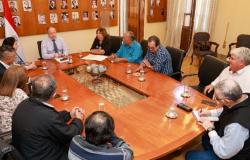Gastre is a city located on the plateau, a dry, arid and mountainous area of the province of Chubut. He June 16, 1996 this small Patagonian town gained national and international prominence. Symbol of the struggle known as the “Antinuclear Epic of Gastre”, which rejected the project of the National Atomic Energy Commission to install a nuclear waste dump in that city.
On that day, dozens of buses, vans and private cars left from the cities of Trelew, Puerto Madryn, Comodoro Rivadavia, Esquel, Rawson, El Bolsón and Bariloche. It was not an improvised mobilization. On the contrary, it brought together previous experiences and debates and different forms of organization that emerged since the end of the eighties to face the project of installing a High Activity Radioactive Waste Repository, in Sierra del Medio, 70 km from Gastre, the first on the planet.
“Chubut stands up and says no to the nuclear waste dump”
Let’s review the facts a little. It’s the nineties. The neoliberal policy of the Menem government was translated into the field of nuclear energy in the search to privatize nuclear power plants and obtain a good income by renting the atomic dump to world powers. The French company Pechiney Ugine Kulhmann wanted to build the nuclear waste dump. The National Government, in exchange, obtained a profitability of US$ 13,500 million in the span of a decade.
A mobilization was called due to the possibility that five committees of the Chamber of Deputies of the Nation would give powers to the National Atomic Energy Commission to decide the location of the nuclear waste dump if an agreement was not reached with the province.
It is worth remembering that the National Atomic Energy Commission, in order to convince of the safety of the “nuclear waste dump,” did not hesitate to forge studies on the Sierra del Medio massif, changing the study of the rock of the province’s massif for a study carried out on granitic rocks of Sweden.
Since the project was announced in the national Parliament, spontaneous events, marches and mobilizations have taken place throughout Patagonia: 3,500 students took to the streets in Caleta Olivia, Santa Cruz, in Puerto Madryn, an immense human chain with more than 5 thousand young people wrote with their bodies, on the sand of the beach: “No to the Nuclear Waste Dump. Patagonia No Nuclear”, in Trelew there were strong mobilizations and activities in Plaza Independencia, and so on in many places. In this way, there was a resounding rejection in all corners of Patagonia.
The slogan to march to Gastre was launched by Javier Rodríguez Pardo, one of the initiators of the movement against the nuclear waste dump and later of the Union of Assemblies of the Community of Chubut (UACCH), in one of the massive concentrations in the Plaza Independencia of Trelew. In a matter of days, dozens of buses were arranged (which were not enough) to transport more than 4,000 registered people. Hundreds of private vehicles were also in the game. There was no national, television or graphic media that has not covered the resounding rejection of the Chubut people to the radioactive grave.
Gastre’s massive march was a definitive slam of the door on the nuclear waste dump project, it defeated the attempt by Carlos Menem’s government to impose the first repository of high-activity radioactive waste on the planet and produced a strong impact on the national media and internationalized a fight against nuclear waste dumps.
The national government did not take into account that the people of Chubut had been fighting tirelessly against the nuclear repository for 13 years. In the 1980s, the initial proposal proposed transferring radioactive waste from the country’s two nuclear power plants, Embalse (province of Córdoba) and Atucha 1 (province of Buenos Aires). 8,000 signatures had been collected in October 1986 and were delivered to the then president Raúl Alfonsín during a visit to Trelew for his centenary.
Mobilization in the streets and organization were the way to confront, be heard and make the conflict visible. The legacy of the Gastre mobilization of 1996 is expressed in dozens of municipalities in the country declared “non-nuclear”, in laws that prohibit radioactive waste, and the inclusion in the provincial and national constitutional reform of articles 110 and 41, respectively, that prohibit the entry of radioactive waste.
Remembering Gastre’s antinuclear feat is essential, it was the first battle won in defense of the environment, predecessor of the battle of Esquel in 2003, by which the province has Law 5001 that prohibited metal mining activity in the open pit modality. and the use of cyanide in mining production processes.
Lessons for the present
In Chubut there is an ancient and triumphant environmental consciousness that permeated the future of several generations of struggle and resistance. Chubutazo is still present in the province, the December 2021 fight against the Arcioni government’s attempt to apply the mega-mining law at the service of Pan American Silver that generated massive mobilizations throughout the province, facing repression, which they managed to defeat. the mining zoning project.
It is essential to return to its lessons in a context where the extractivist attack is the order of the day by the government of Javier Milei and the governors who, like Ignacio Torres and yesterday Mariano Arcioni, seek to make money at any cost.
What happens in Chubut is no different from what happens in other provinces. If the constitutional reform of 1994 gave the provinces power over natural common goods, successive provincial governments used this “cash” to finance their businesses while deepening the country’s dependency and backwardness.
The current governor of the province Ignacio Torres has already declared his support for the Milei plan and the RIGI project (Incentive Regime for Large Investments) that jointly benefits extractivist multinationals and vulture funds, giving free rein for 38 years to looting and their businesses, which in the case of Chubut violates laws such as Law 5001, which prohibits metal mining activity throughout the province.
A model that deepens the plundering of natural assets, supporting fishing predation, real estate and landowner interests, and the always latent threat of forms that are even more polluting and destructive of the environment than mining itself: fracking and the production of green hydrogen, among others. .
It is the continuity of a policy of plunder and environmental destruction in the service of paying the fraudulent foreign debt and maximizing the profits of multinationals, no matter who governs because there are no cracks on this issue.
The discourses of expanding the productive matrix of officials and opponents, in their developmental or liberal versions, endorse extractivism and destroy nature. As we propose from the PTS, in the streets and in the national parliament, It is about fighting in defense of the environment, from an anti-capitalist and socialist perspective.betting on the democratic and independent self-organization of the employers’ parties, so that the workers, with their methods of struggle, in alliance with environmental assemblies, indigenous peoples, the women’s movement, students and youth, with contributions from specialists and scientists, be the ones who define how to protect and use common goods based on comprehensive and rational planning, to satisfy the social needs of the majority in balance with the environment.






